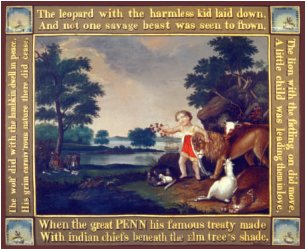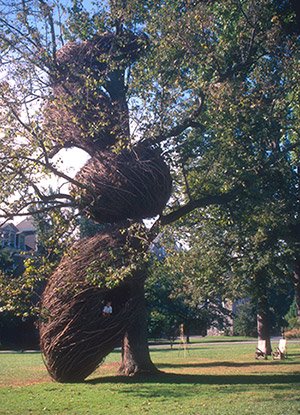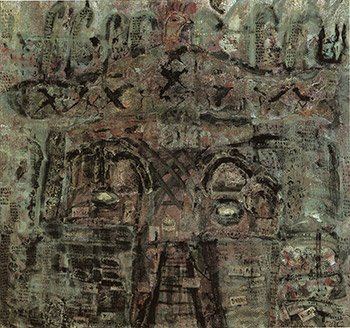Andrea Packard ’85 is gazing at artwork, but her mind is on Virginia Woolf.
“A Room of One’s Own,” she says, referring to the landmark essay. “It may seem obvious, but it really is true. If you don’t have the space to realize your dreams, you can't fully develop them.”
Packard ponders this in the context of The List Gallery, which is celebrating its 25th anniversary at Swarthmore and the publication of a commemorative book [pdf] from Tess Wei ’17.
A gem of the College and greater Philadelphia art scene, the gallery has a rich tradition of bringing together artists, art historians, and students from across all disciplines.
No one has a sharper perspective on the impact of the gallery than Packard, who longed for such a space and opportunity when she was a Swarthmore student. Now an artist and the director of the List Gallery, she delights in fostering lessons and shared conversation for the College community.
“It’s a thrill to see what this space has become,” says Packard, “and it motivates us to keep raising the bar.”
A New Direction

The Peaceable Kingdom by Quaker artist Edward Hicks
In the 1950s, Swarthmore mounted its art exhibits in the common spaces of Parrish Hall. Then came the Florence Wilcox Gallery in Pearson Hall in the 1960s and 1970s, which relocated to Beardsley Hall in the late 1980s.
“That gallery was initially a hallway,” says Packard, who was an English major and art history minor, at a time when students could not receive credit for the visual arts.
Still, the arrow was pointing in the right direction. By 1989, Swarthmore offered studio art as a credit course, and construction had begun on the Lang Performing Arts Center (LPAC). With the support of Vera G. List, in memory of Albert List, the College secured a space in LPAC for a dedicated gallery.
The List Gallery was conceived to house the College’s permanent collection, including Edward Hicks’ The Peaceable Kingdom and its portrait of Benjamin West, display the work of exemplary contemporary artists, and host the senior thesis exhibitions of art majors.
In 1995, Packard came on as the gallery’s first director. When it was time for minor renovations, such as re-doing the floors, that sent the permanent collection to storage, Packard seized the opportunity to showcase more ambitious and contemporary shows in the gallery. They were an instant hit. So the Art Department shifted its focus and fanned the permanent collection across campus.
“It was a new direction for the gallery, but the core function stayed the same,” says Packard. “We continued to showcase exemplary art, but also highlight diverse viewpoints, mediums, creative strategies, and conceptual ideas, in alignment with the values of the College.”
Among the highlights for Packard are the ceramic works of Robert Turner ’36, which embodied Quaker and College values. Another is the towering structure of locally harvested saplings by Patrick Dougherty, built with help from art students, staff of the Scott Arboretum, and community volunteers. But perhaps no exhibit reflects the mission of the gallery more than the ceramics of William Daley, onto which he insisted integrating collages students had created in response to his work.
“That was a real dialogue and a conversation across the generations,” says Packard.
Reflecting on 25 Years

Abracadabra, a 2000 exhibition from Patrick Dougherty, was built with assistance by art students, staff of the Scott Arboretum, and community volunteers.
For nearly 10 years, Packard has offered an internship program, funded since 2013 by the Kaori Kitao List Gallery Endowment, to give real-life experience to students. It's a cross between a museum-studies curriculum and an independent studies project. In the fall of 2015, Tess Wei ’17 walked into the gallery, eager to combine her interests in writing and art history and the visual arts. Coincidentally, the 25th anniversary of the List Gallery was to be recognized the next year.
“I got the idea of creating a catalog that showcased the history and visual diversity of the List Gallery,” says Wei, a studio arts major from Philadelphia, Pa., “and to attract the attention of a wider amount of people on campus.”
Adds Packard: “It was an exciting chance to reflect on what our spaces, staff, and programming means to the community, appreciate what we have, and also project new goals for the future.”
With Packard’s blessing, Wei delved into the filing cabinets to turn a quarter century’s worth of files into a comprehensive list of exhibits. Then she analyzed which shows to illustrate in the book — striking balance between late-career professionals and unknown talents, complex installations and pop-up performances, ceramics and paintings.
“The more I looked at everything, the more powerful it became,” she says. “It was, ‘Wow, this is 25 years.’”
Wei learned page design, toiled on “at least 10 drafts,” managed print production, and even discussed final changes on the phone with Packard after running the Philadelphia marathon.
Along the way, Wei’s view of what the List Gallery represents gained dimension.
"Not just the artists themselves but the themes and exhibits that intersected with social justice or identity,” she says. “It showed me how much is possible in the List Gallery, and how spaces like this can be a platform for those types of important discussions.”
As part of her year-long internship, Wei also interviewed artists, faculty, students, and alumni for their perspectives on the gallery’s impact. Laura Post ’09 remembered the lasting impression that viewing artwork in the List Gallery had on her.
“I tapped into a wealth of artists that went there before and since my short time on campus” says Post, who recently earned an MFA in the printmaking department of the Rhode Island School of Design.
For Professor of Studio Art Syd Carpenter, the gallery spotlights the importance of the visual arts to a liberal arts institution.
“The Art Department itself benefits greatly from having this resource, because it’s an extension of our teaching,” Carpenter says in the catalog. “What we demonstrate in class can be exhibited in reality, tactilely, right there in the gallery.”
‘A Creative Hub for All Constituencies’
More than 20 years into her time at the gallery, Packard continues to be dazzled by what comes through.

Alice Lok Cahara first exhibited Waiting for the Magic Bird, an acrylic and mixed-media piece on canvas, at the gallery in 1995.
“It’s a place that morphs continuously,” she says. “It’s large enough to encompass ambitious exhibits, but intimate enough to provide transformative, almost theatrical experiences.”
Today, the List Gallery both reflects and reaches beyond its history. It means different things to different people, says Packard, who views it as “a library that people can use in their own way.”
For art majors, whose ranks jumped from 12 to 18 in the past year, it’s the training ground for their senior art exhibits. For Zoë Wray ’16, a former gallery intern who produced a catalog [pdf] on the art collected at The Inn at Swarthmore, it was the place to hone her curatorial skills before applying to graduate school. For Packard and her colleagues in the art department, it’s a place of interdisciplinary dialogue, and collaboration with other departments on exhibits like “History, Memory, and Representation: Responses to Genocide.”
But above all, it’s “a crucible of learning,” says Packard, who often gives gallery talks to visiting groups, including classes from the Pennsylvania Academy of the Fine Arts. Most recently, she welcomed 100 area schoolchildren to view and discuss Lois Dodd’s “Windows and Reflections.”
When that exhibit closed at the end of the fall semester, the List Gallery held a reception to mark its anniversary and present Wei’s book, List Gallery: 25 Years, to the College community. For Wei, the highlight was the reaction of community members as they thumbed through the book. “Oh we had that here? They were here?”
For Packard, it was seeing community members from all across campus and beyond coming to celebrate the gallery and the book. She greeted visitor after visitor, beaming, while thinking that her greatest hope for the gallery had come true.
“This is a creative hub for all constituencies,” she says.
Several days later, Packard began installing a pop-up exhibition of her latest work, The Fabric of Nature [pdf]. In something of a Woolfian twist, she had started working on the paintings and assemblages in her own small studio before realizing she needed a bigger space to finish them.
“I could think bigger in the List Gallery and finish pieces I just hadn’t been able to resolve,” says Packard. “It allowed me to see them more clearly, and to know what to do next.”

















